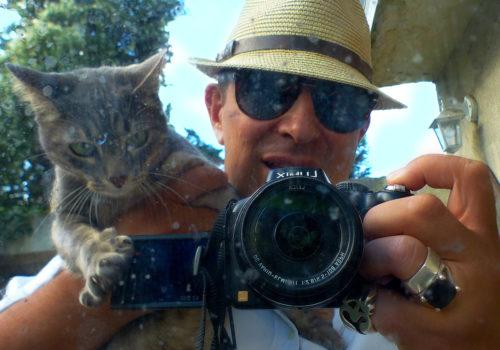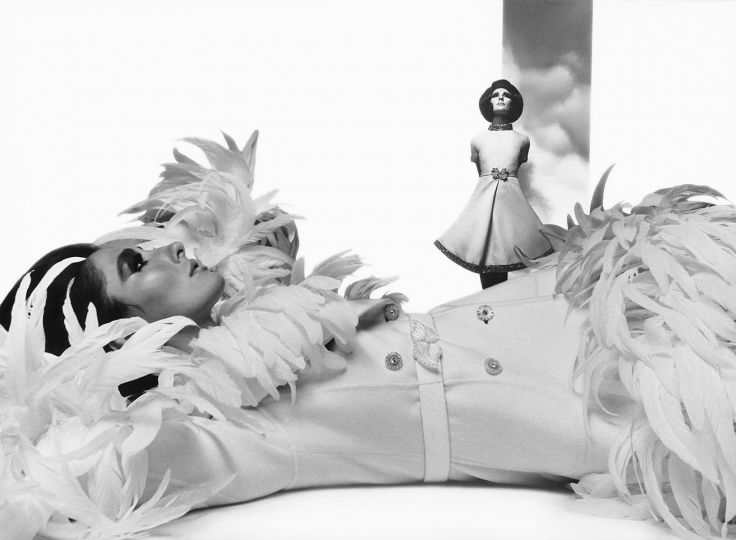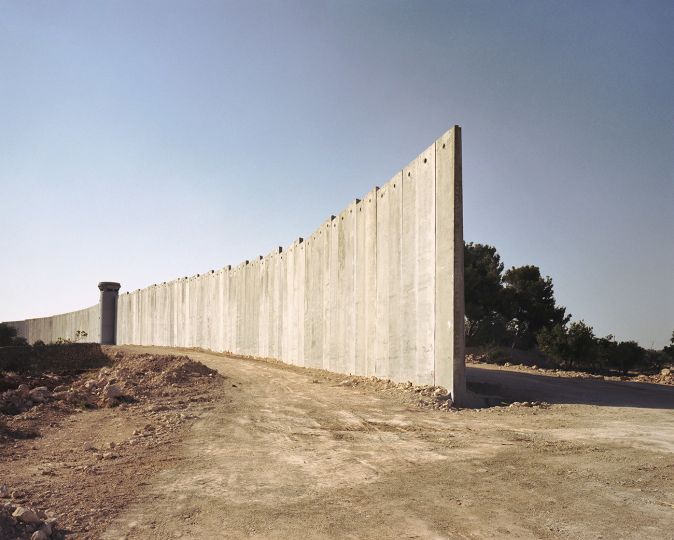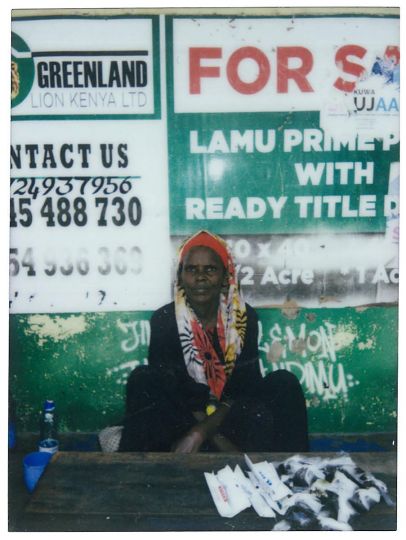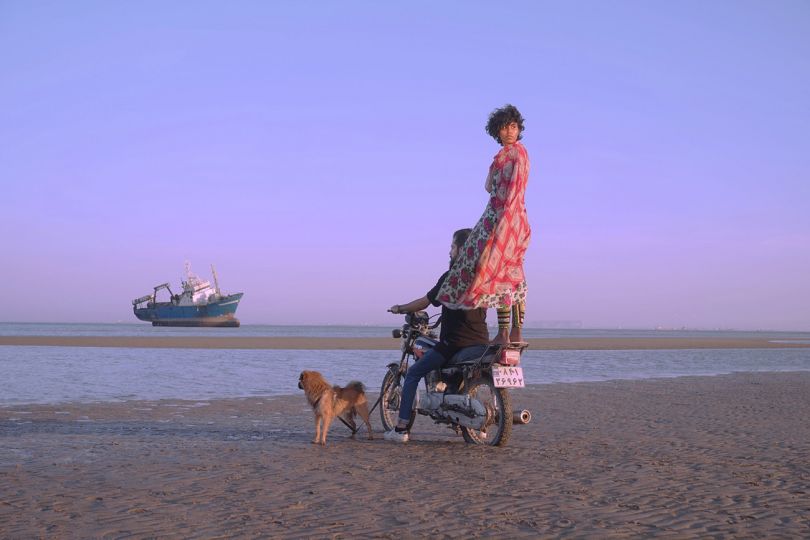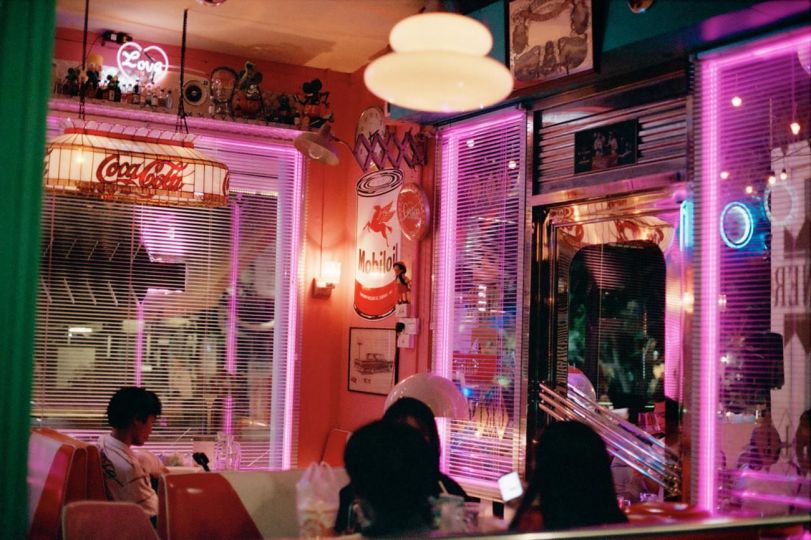Laurent Goldstein : The human dimension above all.
Trained as an architect, Laurent Goldstein is above all a multi-talented artist, since he is also an illustrator, author and producer of films and musical shows, and a portrait photographer.
It was when he was creating costumes for the theater and cinema that his destiny changed to Haute Couture. Indeed, Madame Carven made him take a first decisive turn, allowing him to sign ready-to-wear collections and to collaborate in the development of several other lines of his fashion house. He was then just 24 years old.
This experience would later open the doors to other major haute-couture houses in Paris, London and Milan, before he joined the French ready-to-wear federation as artistic director before creating Red Halo, his own company of high-end products for the home. Collections made mainly of embroidered textiles that also allow him to do humanitarian work. From then on, he divided his life between Benares (in the Indian state of Uttar Pradesh) and Paris.
It is also in India, through photography discovered at university in the United States-, that he explored his “search for lost time”. Benares, the oldest still inhabited city on the planet, became his “Proust’s madeleine”. There, the real world coexists with a certain idea of timelessness, linking us to the origins of humanity. A way for him to extend his vision on the world and to show the numerous aspects of the Indian society sometimes deeply attached to its traditions or on the contrary turned towards the future.
Laurent thus continues his human adventure. He captures moments that immortalize the richness of the many Indian cultures and traditions, forever fixing the faces of those who pass in front of his lens at random. Cultural personalities, artisans, anonymous people, collaborators, friends or other living beings from the animal world, allowing him to bring people together and show that we are all linked in one way or another.
And to contribute to this country that has given him so much, his photographic work has naturally been put at the service of organizations that help children, particularly in the field of education.
His photographic work has also been published in numerous publications including: Le Monde – Le Point – Condé Nast Traveller – The Huffington Post – Shubh Yatra (Air India Magazine) – The Times of India – The Indian Express – Geo Histoire – La Croix – Cartier Magazine – Le Un Hebdo – Galaxy – Altum – Lonely Planet India …
Site: www.laurentgoldstein.photography
Instagram: @laurentgoldstein_official
Facebook: www.facebook.com/laurent.goldstein.photography
Chaîne Youtube: LAURENT GOLDSTEIN Photography
Your first photographic trigger?
Laurent Goldstein : There was a photography course in the American university where I was an art student, I went there to ask how to use my camera. Dr. Ericha Scott taught me how to develop film and shoot photos, and she opened a Pandora’s box from which I have never emerged.
Who is the man or woman of image who inspires you?
Laurent Goldstein : The choice is impossible between Henri Cartier-Bresson, Raghu Rai, photographers of the 19th century like Samuel Bourne, Madho Prasad or Brajo Gopal Bromochary, as well as Alfred Stieglitz and Edward Steichen (for portraits).
What image would you like to have made?
Laurent Goldstein : One of the beautiful photos on the set taken by my friend, the young and talented Taha Ahmad during the shooting of Mira Nair’s series “A Suitable Boy”. This photo with the actors Tabu and Ishan Khatter represents everything that is dreamlike in the culture of Uttar Pradesh, it restores the sophistication that reigned in Awadh, the province of Oudh of which Taha is the worthy heir.
Which one moved you the most?
Laurent Goldstein : A photo by the remarkable Indian photojournalist Moushumee K Jha, taken during the riots in Delhi that began on February 23, 2020, following the new Citizenship Amendment Act, where Hindu nationalists brutalized members of the Muslim community, leaving 53 dead (40 Muslims, 13 Hindus), hundreds wounded, and entire neighborhoods burned and looted. His photo moved me because it sums up three days of horrors that we thought belonged to a bygone era and also because all this took place in places I know well.
Which one made you angry?
Laurent Goldstein : One of my photos taken on the banks of the Ganges, hacked, hijacked and taken out of context in order to lynch and condemn a group of Indian students who were innocent in a university in Sri Lanka.
A key image in your personal pantheon?
Laurent Goldstein : A photo I found at Doubleday’s in Broadway (New York) when I was a teenager which is a reproduction of a portrait of Claude Monet taken by Adolf de Meyer in March 1921. This fabulous artist was 86 years old, it is one of his last photos yet his look is sparkling and mischievous, he is handsome. This photo has never left me.
A photographic memory from your childhood?
Laurent Goldstein : Reading “Bharat” (India: Men, Rites and Gods) a book of photographs by Jean-Louis Nou which, unconsciously, influenced all my work.
Without any budget limit, what would be the work you would dream of acquiring?
Laurent Goldstein : “Vishnu Pud and other temples” a photograph made in Benares in 1865 by Samuel Bourne. This image of Manikarnika Ghat is remarkable for its composition, its contrasts and above all the subject which allows me to see that nothing has changed since then, apart from the temple in the foreground which has sunk toward the Ganges and now leans like the tower of Pisa.
According to you, what is the necessary quality to be a good photographer?
Laurent Goldstein : The understanding of light.
The secret of the perfect image, if it exists?
Laurent Goldstein : A fraction of a second where the eye analyzes the light, the composition and the emotions. It is a very quick intuitive disposition, almost unconscious, which is Cartier-Bresson’s “Decisive Moment”.
The person you would like to photograph?
Laurent Goldstein : The next person who asks me.
An indispensable photo book?
Laurent Goldstein : “Henri Cartier-Bresson in India” ( Thames & Hudson Ltd). The best photos taken by Cartier-Bresson during his six trips to India from the independence to 1987.
The camera of your childhood?
Laurent Goldstein : A Canon A1.
The one you use today?
Laurent Goldstein : I use an all-terrain camera, the Panasonic Lumix DMC-FZ200, which has a Leica lens that can withstand extreme temperatures or humidity and gives me the greatest freedom in my work.
Your favorite drug ?
Laurent Goldstein : Dark chocolate.
The best way to disconnect for you?
Laurent Goldstein : Spending time with animals more than with humans, I love them all and they know how to give it back to me, whether it’s the monkeys living on the roof of Benares’ house or Chérie, the little cat who shares my life.
What is your relationship with the image?
Laurent Goldstein : It’s a fusional relationship, I make and feed on images.
What is your greatest quality?
Laurent Goldstein : I am a colorist, the use I make of color would be, according to my professional entourage, my strong point, my quality.
Your last folly?
Laurent Goldstein : More than a folly, my last exhibition where I was able to encourage my friends to buy my photographic work in order to finance the university studies of young Indian bachelors in distress through Indo-French Scholarship, the program launched with GOPIO, the Indian organization I support.
An image to illustrate a new banknote?
Laurent Goldstein : I don’t know, I’m not a money man.
The job you would not have liked to do?
Laurent Goldstein : A repetitive and routine job.
Your greatest professional extravagance?
Laurent Goldstein : Forgetting that I am still a human being when I have a camera in my hand and not taking into account certain dangers.
What do you think are the bridges between photography and design?
Laurent Goldstein : An exchange of references, photography and design feeds each other. However, as a photographer and designer, I switch from one discipline to the other depending on what I want to express, both allow me to tell something without having to use words. However, design is the translation of an idea that does not exist, then photography allows to sublimate it.
Which city, country or culture do you dream of discovering?
Laurent Goldstein : All of them, they are all interesting for a photographic eye even if I have a deep attraction for all the cities and cultures of the East which extends for me from Morocco to China, with India as the quintessence.
The place you never get tired of?
Laurent Goldstein : A boat on the Ganges River in Benares at sunrise where I always have the impression of witnessing the creation of the world.
Your biggest regret?
Laurent Goldstein : Not to see people I have loved and who are no longer of this world.
In terms of social networks, are you more into Instagram, Facebook, Tik Tok or Snapchat and why?
Laurent Goldstein : Instagram because it has become a must for the image and Facebook where a real active community has been built over time on the page dedicated to my photographic work.
Color or B&W?
Laurent Goldstein : I started with B&W then I switched to color, India being the land of colors; but for the past few years I have been returning to B&W which I alternate according to the subjects that come before my lens.
Daylight or artificial light?
Laurent Goldstein : Natural light, so daylight.
What is, according to you, the most photogenic city?
Laurent Goldstein : Benares without any doubt, the light is particular, always different depending of the hours and the seasons.
If God existed, would you ask him to pose for you, or would you opt for a selfie with him?
Laurent Goldstein : Neither, I imagine him to be omniscient, omnipresent and omnipotent and therefore impossible to photograph.
If I could organize your ideal dinner, who would be at the table?
Laurent Goldstein : A dinner for two with Sister Emmanuelle who will always remain a guide for the social work and humanitarian actions I undertake. She brings energy when I am in doubt or in complicated situations, I still have a lot to learn from her and she is missing in our time.
What image represents for you the current state of the world?
Laurent Goldstein : A war photo taken on March 6, 2022 in Irpin, Ukraine, showing the bodies of Tatiana Perebeynos and her children Nikita and Alise murdered by the Russians. This image is unbearable, it sums up the current state of the world through its factual context but also because some under the influence of a shameful propaganda want to question it. Fake news has taken over our era and too many people are letting themselves be manipulated.
What is missing in today’s world?
Laurent Goldstein : Obviously more tolerance and compassion.
If you had to start all over again?
Laurent Goldstein : I would certainly do it all again in the same way.
The last word ?
Laurent Goldstein : Photography is an extraordinary medium to meet all kinds of people and exchange a moment of their life that I immortalize through an image. It is the medium that offers the most freedom to my work, that allows me to experience extreme sensations, to dream, to learn, to create and above all to share, to testify or to allow someone to escape. A photo is not made alone, it is an intimate moment between the photographer and his subject, whether it is alive or an object, a landscape, and it is this moment which interests me where I question myself each time, where I have the impression in a certain way to be able to reinvent myself. Beyond an artistic discipline, photography has also confirmed to me that we are all brothers and sisters, that when we take off our make-up , the saris, the turbans we all share the same emotions wherever we are, whatever our social and cultural background. There is nothing better to appreciate life in all its forms.

